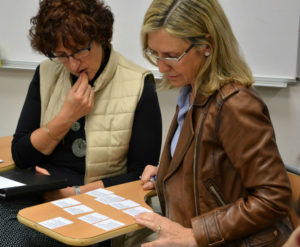Managing and Leading Student Behaviour
In-house teacher training
This course is also available online
1 week
Course Length
Flexible
Lesson Days
15
Lessons
English
Language
B1
Minimum Level
Overview
Positive pupil behaviour is a pre-requisite for effective teaching and learning. Based on up-to-date research and effective classroom practice, this course will offer practical strategies for managing pupil behaviour in schools so that learning can take place in calm, ordered and positive classroom environments where pupils can achieve their full potential in every lesson.
Participants will initially focus on effective approaches for managing whole-class behaviour by employing routines and strategies to build positive relationships, motivating pupils to engage in learning and preventing low-level disruption. Following this, participants will consider how to support pupils who display challenging behaviour through the use of de-escalation techniques and long-term programmes for behaviour improvement.
Completing this course will help you:
- Understand how to develop ‘classroom presence’ through the effective use of voice and body language
- Understand how to develop positive relationships and motivate pupils to engage in learning
- Explore how to establish routines and procedures that lead to the smooth running of classrooms and across the school
- Know how rules, rewards and sanctions can be used effectively to manage whole-class, groups and individuals
- Know how to respond to challenging behaviour using appropriate de-escalation techniques and behaviour recovery systems
- Explore strategies for improving the long-term behaviour of challenging pupils
- Consider how to prevent and respond to incidents of bullying in schools.
Who is the course for?
For teachers who want to acquire knowledge of how to respond to challenging behaviour using appropriate de-escalation techniques and behaviour recovery systems.
Course Sample programme
| Week 1 | Course Content |
| Day One | Develop classroom presence and positive relationships |
| Day Two | Establish routines and procedures |
| Day Three | Know how rules, rewards and sanctions |
| Day Four | Respond to challenging behaviour |
| Day Five | Review and Feedback |
*Please note that the course content may be subject to change due to latest methodology trends updates. 1 lesson=45mins
Share This Class:
What people are saying



In-House Training
You might also be interested in these courses

Supporting pupils with Special Educational Needs and Disabilities
This course develops the skills of those involved in the education of pupils with Special Educational Needs and/or Disabilities (SEND) so that these children…

Higher Order Thinking
Developing Higher Order Thinking requires teachers to establish with their student a knowledge base of thinking skills, reasoning, critical thought, and problem-solving…

Scaffolding
With our workshop “Scaffolding” you will understand in more details on how to support second language learners by providing helpful hints to help students…
More Courses in the UK, Ireland and Malta
You might also be interested in these courses

Technology for Language Teachers
Technology for Language teachers is aimed at teachers who want to use more technology in the classroom to enhance the learning experience of their students…

Teaching for Exam Classes
Teaching for Exam Classes is for English teachers who are preparing teenage or adult students for exams. Preparing to teach Cambridge or IELTS exam class. London…

Pronunciation and Performance with an expert “Adrian Underhill”
Pronunciation and Performance with an expert is a course led by a world-renowned ELT Consultant and Trainer. Adrian Underhill is an author and the series…
Methodologies

Total Physical Response
Total Physical Response is considered to be an excellent way of learning vocabulary. Moreover, since it is based on commands, the students can easily learn the meaning of the words in the target language.

The Structural Approach
This method is based on the opinion that it is imperative to understand the structures of the language. Understanding the complexities of the structures of the sentences in a language is more important than learning the vocabulary of the language.

The Direct Method
This method primarily focuses on the development of oral skills. One of the most important characteristic feature of this method is that visual materials and real-life objects are used. Moreover, such an oral training helps in reading and writing. There is no translation involved in this method.
